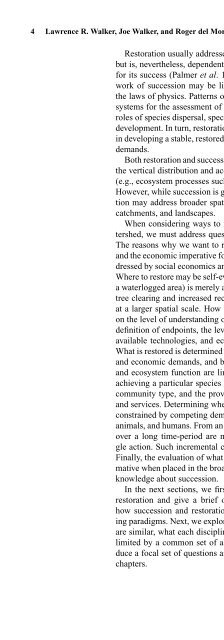Linking Restoration and Ecological Succession (Springer ... - Inecol
Linking Restoration and Ecological Succession (Springer ... - Inecol
Linking Restoration and Ecological Succession (Springer ... - Inecol
You also want an ePaper? Increase the reach of your titles
YUMPU automatically turns print PDFs into web optimized ePapers that Google loves.
4 Lawrence R. Walker, Joe Walker, <strong>and</strong> Roger del Moral<br />
<strong>Restoration</strong> usually addresses shorter time scales than successional studies,<br />
but is, nevertheless, dependent on the broader successional patterns of change<br />
for its success (Palmer et al. 1997). Practicing restoration outside the framework<br />
of succession may be likened to building bridges without attention to<br />
the laws of physics. Patterns of successional development can offer reference<br />
systems for the assessment of restoration actions <strong>and</strong> critical insights into the<br />
roles of species dispersal, species interactions, plant–soil interactions, <strong>and</strong> soil<br />
development. In turn, restoration offers a practical test of successional theories<br />
in developing a stable, restored system within the constraints of socioeconomic<br />
dem<strong>and</strong>s.<br />
Both restoration <strong>and</strong> succession can focus on structure <strong>and</strong> composition (e.g.,<br />
the vertical distribution <strong>and</strong> accumulation of biomass <strong>and</strong> species) or function<br />
(e.g., ecosystem processes such as the flow of energy or cycling of materials).<br />
However, while succession is generally confined to a given ecosystem, restoration<br />
may address broader spatial scales <strong>and</strong> encompass adjacent ecosystems,<br />
catchments, <strong>and</strong> l<strong>and</strong>scapes.<br />
When considering ways to restore a habitat, l<strong>and</strong>scape, ecosystem, or watershed,<br />
we must address questions about why, where, how, what, <strong>and</strong> when.<br />
The reasons why we want to restore are largely influenced by societal values<br />
<strong>and</strong> the economic imperative for sustainable resources <strong>and</strong> services, <strong>and</strong> are addressed<br />
by social economics <strong>and</strong> governmental policies (Costanza et al. 1992).<br />
Where to restore may be self-evident, but in many cases, the targeted area (e.g.,<br />
a waterlogged area) is merely a symptom of a broader problem (e.g., extensive<br />
tree clearing <strong>and</strong> increased recharge into the water table) that needs attention<br />
at a larger spatial scale. How to successfully restore an area depends largely<br />
on the level of underst<strong>and</strong>ing of the main drivers of the overall system, a clear<br />
definition of endpoints, the level of degradation (perhaps a new system state),<br />
available technologies, <strong>and</strong> economic constraints (Walker <strong>and</strong> Reuter 1996).<br />
What is restored is determined by existing conditions, social attitudes, political<br />
<strong>and</strong> economic dem<strong>and</strong>s, <strong>and</strong> by ecological constraints. Biodiversity, stability,<br />
<strong>and</strong> ecosystem function are linked to the particular restoration goals such as<br />
achieving a particular species composition, ensuring the duration of a certain<br />
community type, <strong>and</strong> the provision of necessary or desired ecosystem goods<br />
<strong>and</strong> services. Determining when to restore is complex <strong>and</strong> the decision can be<br />
constrained by competing dem<strong>and</strong>s for funding or perceived threats to plants,<br />
animals, <strong>and</strong> humans. From an ecological perspective, many sequential actions<br />
over a long time-period are more likely to yield desired results than a single<br />
action. Such incremental change over time defines ecological succession.<br />
Finally, the evaluation of what constitutes successful restoration is most informative<br />
when placed in the broader ecological context of expectations based on<br />
knowledge about succession.<br />
In the next sections, we first define our perceptions about succession <strong>and</strong><br />
restoration <strong>and</strong> give a brief overview of each discipline. Then we discuss<br />
how succession <strong>and</strong> restoration differ in scale, subject matter, <strong>and</strong> underlying<br />
paradigms. Next, we explore in more detail how succession <strong>and</strong> restoration<br />
are similar, what each discipline has to offer the other, <strong>and</strong> how they are both<br />
limited by a common set of abiotic <strong>and</strong> biotic constraints. Finally, we introduce<br />
a focal set of questions <strong>and</strong> provide a summary of each of the following<br />
chapters.

















